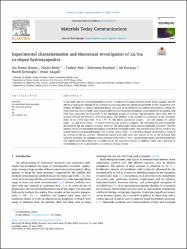| dc.contributor.author | Hssain, Ala Hamd | |
| dc.contributor.author | Bulut, Niyazi | |
| dc.contributor.author | Ateş, Tankut | |
| dc.contributor.author | Köytepe, Süleyman | |
| dc.contributor.author | Kuruçay, Ali | |
| dc.contributor.author | Kebiroğlu, Hanifi | |
| dc.contributor.author | Kaygılı, Ömer | |
| dc.date.accessioned | 2022-07-20T09:17:22Z | |
| dc.date.available | 2022-07-20T09:17:22Z | |
| dc.date.issued | 2022 | en_US |
| dc.identifier.citation | Hssain, A. H., Bulut, N., Ates, T., Koytepe, S., Kuruçay, A., Kebiroglu, H., & Kaygili, O. (2022). Experimental characterization and theoretical investigation of Zn/Sm co-doped hydroxyapatites. Materials Today Communications, 103850. | en_US |
| dc.identifier.issn | 2352-4928 | |
| dc.identifier.uri | https://doi.org/10.1016/j.mtcomm.2022.103850 | |
| dc.identifier.uri | https://hdl.handle.net/20.500.12899/1160 | |
| dc.description | Received 28 March 2022, Revised 30 May 2022, Accepted 13 June 2022, Available online 17 June 2022, Version of Record 18 June 2022. | en_US |
| dc.description.abstract | In this study, the wet chemical method was used to synthesize Zn-doped hydroxyapatite (HAp) samples, and the effects of varying the amount of Sm addition on structural, thermal, and biocompatibility in vitro properties were studied. In addition, a density functional theory was used for modeling the as-synthesized samples to obtain the theoretical calculation results. XRD results confirmed the formation of biphasic compositions for all samples, and FTIR data supported the formation of the functional groups of hydroxyl and phosphate. More than 98% of samples showed the formation of the HAp phase. The addition of Sm resulted in an increase in the secondary phase of the β-TCP from 0.60% to 1.49%. The lattice parameters (aandc),unit cell volume (V), lattice strain(ε), and lattice stressσ varied when Sm was added as a dopant. The crystallite size and crystallinity decreased as the Sm content increased, however, the anisotropic energy density gradually increased. Thermal analysis results confirmed that all samples seemed to be thermally stable. The addition of Sm did not result in any notable morphological modifications. Cell viability values of theZn-based HAp sharply decreased as a result of an increase in the Sm additive. Theoretical studies show that when the amount of Sm in the Zn-based HAp structure increases, the bandgap energy decreases from 4.68 to 4.40eV. An increasing density and decreasing unit cell volume have been observed, as confirmed by the theoretical results. In addition, there was a decrease in crystallinity as well as an increase in anisotropic energy density. | en_US |
| dc.language.iso | eng | en_US |
| dc.publisher | Elsevier | en_US |
| dc.relation.isversionof | 10.1016/j.mtcomm.2022.103850 | en_US |
| dc.rights | info:eu-repo/semantics/closedAccess | en_US |
| dc.subject | Ion-substituted hydroxyapatite | en_US |
| dc.subject | Wet chemical methodt | en_US |
| dc.subject | Sm | en_US |
| dc.subject | Zn | en_US |
| dc.subject | Cell viability test | en_US |
| dc.title | Experimental characterization and theoretical investigation of Zn/Sm co-doped hydroxyapatites | en_US |
| dc.type | article | en_US |
| dc.authorid | 0000-0002-4519-2953 | en_US |
| dc.department | MTÖ Üniversitesi, Mühendislik ve Doğa Bilimleri Fakültesi, Mühendislik Temel Bilimleri Bölümü | en_US |
| dc.contributor.institutionauthor | Ateş, Tankut | |
| dc.identifier.volume | 31 | en_US |
| dc.identifier.startpage | 1 | en_US |
| dc.identifier.endpage | 15 | en_US |
| dc.relation.journal | Materials Today Communications | en_US |
| dc.relation.publicationcategory | Makale - Uluslararası Hakemli Dergi - Kurum Öğretim Elemanı | en_US |


















